
When Agriculture Secretary Tom Vilsack visited our state this month, he highlighted $19.5 billion in new conservation funding through the Inflation Reduction Act. One of the priorities for this funding is assisting producers with nutrient management.
Nutrient management is an important practice for protecting surface and ground water that became a higher priority as fertilizer costs have gone up. Higher costs make it even more important to apply fertilizers at the right time and at the right rate to maximize efficiency while reducing the impact of fertilizers on water quality. The USDA estimates that 89 million acres of cropland (28% of total U.S. cropland) currently exceed the nitrogen loss threshold; and if all those acres implemented a nutrient management plan, the average net savings would be $2.6 billion.
NRCS recently announced grant opportunities for nutrient management through the Regional Conservation Partnership Program. The funding will go to regional projects emphasizing nutrient management practices, the deadline for proposals is Oct. 31, through Grants.gov.
In addition to grant and program financial assistance opportunities, USDA is launching an outreach campaign to highlight the economic benefits of nutrient management. The agency also seeks to expand the number of private Technical Service Providers to assist producers with nutrient management planning.
~
NRCS-Michigan held a listening session with Grand Rapids-area urban growers as part of the process of establishing an urban agriculture office to serve the area. The event was hosted by New City Neighbors at their new farmstead facility in the Creston Neighborhood. NRCS and the Farm Service Agency will jointly open two urban agriculture offices serving Grand Rapids and Detroit-area growers.
|
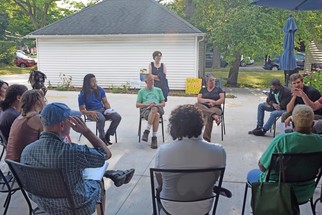
District Conservationist Di'Shun Melbert facilitates a discussion with urban farmers in Grand Rapids during a listening session held at New City Partners.
|
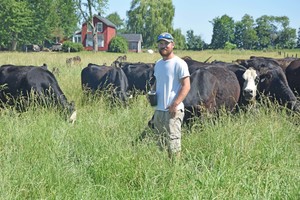
Eaton County farmer Evan Boehmer believes in having his cattle do the work for him. Rather than hanging around in a feedlot where he must provide them forage, his 80 Angus cow-calf pairs spend their time finding their own food in his variety of cool season perennial and warm season annual pastures.
“It’s very simple, couldn’t be simpler, make the cattle work for me,” said Boehmer about how he manages his beef herd.
Boehmer’s goal is to graze his cattle at least nine months out of the year or more if weather permits and a prescribed grazing plan through the NRCS Environmental Quality Incentives Program (EQIP) has helped guide him. His cattle are divided into three herds on different pastures that are divided into separate paddocks. Once a herd has grazed long enough, based on length of time and forage height, he moves them to a new paddock. This allow the forage to rejuvenate before it is grazed again, averaging 30-45 days rest to regrow.
“I’m like a nomad, moving cattle all the time,” said Boehmer.
The right infrastructure is required to operate a prescribed, rotational grazing operation. For starters, fencing is needed to restrict the cattle’s grazing to a limited area and they must have access to water no matter where they are feeding. Boehmer’s cattle operation started on his mother’s farm with a herd of 25 cow-calf pairs. He received financial assistance through EQIP to install over 5,000 feet of fencing, over 1,600 feet of water pipeline, and two watering facilities. Boehmer later expanded his operation to a neighbor’s land. The neighbor was already set up for rotational grazing through his own previous EQIP contract.
In addition to grazing on pasture, Boehmer found another way to get his cattle to work for him and keep them off the feedlot. A neighbor allows him to graze his cattle on corn stalks during late fall and winter when soil conditions allow. Boehmer estimates that feeding his cattle on corn stalks instead of hay saves him about $2,000 a week in feed. It also benefits his neighbor’s field, where the cattle fed on corn stalks there were fewer weeds, free nutrients spread from the manure, and less volunteer corn the following year. He also grazed his cattle on a different neighbor’s cover crops following winter wheat harvest in the fall and found this extended his grazing by over a month in the fall after his normal pastures had gone dormant. Boehmer benefited by reducing the amount of cut hay he needed to feed which allowed him sell some of his round bales for income.
Boehmer and his neighbor ran an informal trial comparing the winter wheat acres where he planted a cover crop and grazed cattle, with adjoining wheat land with no cover or grazing. There was a dramatic qualitative difference on the area that was grazed, said former NRCS District Conservationist, Tim Redder. The soil appeared darker, was mellower, had fewer weeds and contained many more earth worms.
Boehmer grazes his cattle on three pastures totaling about 135 acres and grows forage on an additional 200 acres. The cattle provide all the fertilizer he needs on his pastureland while grazing and he applies the manure from where he winters them on his hay acres the following spring. “I’m trying not to spend any money on added inputs,” said Boehmer.
He believes his cattle are healthier grazing on the variety of forages than they would be if they were in a feedlot and has observed a significant improvement in overall herd genetics and calving. There’s little to no sickness in his herds, Boehmer said. He sells his cattle mainly for breeding or as bred cows but finishes a few each year as well.
Hardworking, healthy beef cattle are working for Boehmer. He plans to expand his operation to 100 or 125 cow-calf pairs, but not quickly. “Nothing should be quick with a cow.”
|

Nicholas Williams joined NRCS-Michigan in June as our new Assistant State Conservationist for Programs. Prior to coming to Michigan, Williams served as a resource conservationist in Jackson, Miss., where he oversaw the state’s Environmental Quality Incentives Program.
Williams started his NRCS career in 2011 as a student trainee in Spencer, Iowa. Following his graduation from Tennessee State University with a degree in Business Agriculture, he accepted a full-time position as a soil conservationist in Donnellson, Iowa. He later served as a soil conservationist in Georgia and as a district conservationist in Indiana. While in Mississippi, Williams participated in the NRCS Leadership Development Program which included a detail in Auburn, Ala., as the assistant state conservationist for management and strategy.
Williams is a native of Nashville, Tenn. He and his wife Victoria have an infant daughter, Emerie. Williams’ interests include spending time with family, movies, and travel. He also enjoys following sports and is an avid fan of the Tennessee Titans.
|

The 80 acres of woods for hunting and recreation that Jim and Shirley McLean purchased in the 1970s has grown, literally and figuratively into much more. What is now the McLean Nature Preserve covers 120 acres and serves as a sanctuary for nature lovers, wildlife, and honey bees.
“We want to protect the land, and for people to enjoy the land, it’s our legacy,” said Jim McLean.
The original 80 acres the McLeans purchased was mostly woods along the North Branch of the Kawkawlin River in Bay County. They enrolled the land in a conservation easement with the Saginaw Bay Land Conservancy. They later purchased two additional 40-acre parcels which were also enrolled into conservation easements. Unlike the original 80 acres, some of the additional land they acquired was farm land. The McLeans decided to establish native wildflowers on a portion of the property and sought assistance from NRCS.
They were able to receive financial assistance for planting wildflowers through the Environmental Quality Incentives Program (EQIP). Utilizing the conservation cover practice, they established a variety of wildflowers including milkweed, foxglove, prairie blazing star, and many others. After the wildflowers were established, McLean invited a local beekeeper to keep hives on the property.
Wayne and Roxanne Kingham own King Honey and keep about 300 hives at about 12 to 15 sites from Bay City to Twining, from May to October. The Kingham’s bees spend the summer in Michigan in between pollinating almond trees in California and overwintering in Georgia. They have kept hives at the McLean preserve for about 15 years, said Wayne. “The property has a kaleidoscope of color and lots of milkweed.”
All of the honey the Kinghams harvest is what the bees produce while in Michigan. He prefers to keep his hives as far from commercial agriculture as possible to avoid pesticides. Kingham said he is always on the lookout for potential sites to keep his bees. Programs like EQIP that encourage establishing native flowers are a blessing for beekeepers, said Kingham.
The McLean Preserve is open to the public by appointment and they have hosted tours and educational events there for about the last 10 years, said McLean. The property has miles of trails and a variety of wildlife including otters, mink, and bobcat. The McLeans host nature walks that highlight whatever flowers are in bloom as well as events like mushroom walks and programs on raptors. The Kinghams present a session on beekeeping.
The McLeans created a non-profit for the sanctuary and plan to leave the land to the Saginaw Bay Conservancy to serve as their legacy.
|
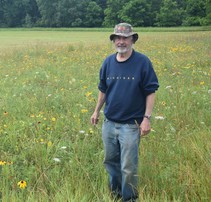
Jim McLean standing in one of the wildflower plantings at the McLean Nature Preserve in Bay County. McLean and his wife Shirley established the preserve after they retired from Dow Chemical in Midland. The preserve offers events several times a year including wildflower walks.
|
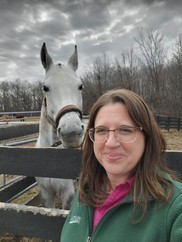
Andrea Wendt started her conservation career with the
Shiawassee Conservation District in 2006. She spent 13
years as the Watershed Technician developing watershed
management plans and reaching landowners and farmers in high-risk watersheds. Andrea is very detail-oriented, and she sees how small actions can affect the bigger picture. She communicates well with people and has a knack for
explaining technical concepts in a way that makes sense for the audience. This skill has helped her tailor educational programs for groups of all ages and sizes.
“Teaching conservation is one of my favorite parts of this job! I love seeing the faces of people when they learn how they can make a difference in protecting our earth,” said Wendt.
In 2019, Andrea took on a new role working one-on-one with farmers to help them
voluntarily comply with Michigan Right to Farm rules through the Michigan Agricultural
Environmental Assurance Program (MAEAP). She addresses whole farm operations and
works to implement changes no matter their size. She has worked as a conservation
planner since the start of her career but has taken it to the next level by recently becoming a Certified Conservation Planner.
“Each farm visit is a great opportunity to create a baseline for the operation. Patience and
understanding are key to gaining trust and follow through. Sincerely listening to each farmer’s story helps me understand how conservation can help the farmer achieve their
goals, while also helping our environment,” Wendt states. “Farmers appreciate the history of conservation but may be unsure that it will work for them. Providing sound guidance,
balanced with understanding of the farm situation, is how I’ve found to grow that relationship and be successful.”
Becoming a Certified Planner provides the framework to take a dynamic landscape and
explain the impact conservation can have on it to the landowner. The process clearly lays
out the tools to develop the skills needed to read the land, meet the landowner where they
are, and explain the outcomes from making the change to adopt conservation. There are
many different directions a conservation plan can take; it is important to know the goals of
the landowner and have the technical understanding of how practices affect natural
resources.
“At first, the certification seemed out of reach. However, going through the process provided sound guidance and helped me become more confident about my abilities to be a good planner. I’m proud of my accomplishment in becoming a Certified Planner. I think it shows my commitment to conservation and helps producers feel they are in good hands with their land,” says Wendt.
“Conservation planning provides the foundation for all of the recommendations that the
conservation partnership provides to landowners whether they have natural resource
concerns or not. As a Certified Conservation Planner, Andrea will be able to provide well
thought-out alternatives to her customers that will give them the best chance at success for improving sustainability on their land. Having Andrea as a resource in the local field office is a great asset to NRCS and our partners who want to see conservation on the land,” said Heather Varboncoeur, NRCS Conservation Planning Specialist.
The NCPP appreciates the commitment of hark-working, dedicated District employees such as Andrea. Their commitment is critical to the conservation planning process and helping others understand the mission of putting conservation on the land.
|

All of the climate monitoring stations installed through an agreement with NRCS and three American Indian tribes in Michigan are now operational.
The three stations are transmitting data which is available online through the Tribal Soil Climate Analysis Network. The stations are located at sites chosen by the Pokagon Band of Potawatomi, the Match-E-Be-Nash-She-Wish Band of Potawatomi Gun Lake Tribe, and the Saginaw Chippewa Indian Tribe.
The Tribal Soil Climate Analysis Network supports natural resource assessments and conservation activities through its network of automated climate monitoring and data collection sites. The network focuses on agricultural areas which are situated on Tribal lands in the United States.
|
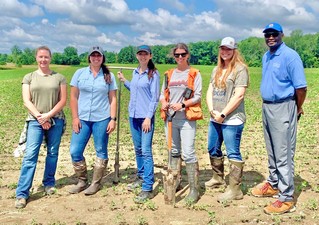
Area 4 staff (southeast Michigan) participated in a Conservation Reserve Program training course in July. Area 4 technicians and Farm Bill biologists visited several sites to learn about their unique soils and other characteristics.
|

Devon Brodie - MLRA Soil Scientist, Flint
Last Position: Soil Scientist, Colchester, Vt.
Home Town: Ann Arbor
Education: B.A. Environmental Sciences, Policy and Management, Master of Science, emphasis in Soil Science - University of Minnesota
Family: wife Hannah
Hobbies & Interests: Spending time with wife and dogs, hiking, camping, swimming, fishing, disc golf, hunting
|
Employee Updates
Ben Thelen - District Conservationist - Flint (formerly District Conservationist - Saginaw)
Matthew Swain - District Conservationist - Charlotte (formerly Soil Conservationist - Mason)

September
8 - Washtenaw MAEAP Field Day, 8 a.m. to 11:30 a.m., Brines Farm - Whitmore Lake, for more information and to register go to washtenawcd.org
8 - Project Wingspan: Agricultural Lands & Habitat Management Workshop, 9 a.m. to 3:45 p.m., Kellogg Biological Station - Hickory Corners, for more information and to register go to www.pollinator.org/wingspan/
9 - Perennial Farm Ecosystem Conference, 9 a.m. to 4 p.m., Leelanau Government Center Community Meeting Room - Suttons Bay, for more information and to register go to www.leelanaucd.org
21 - 2022 Pasture Walk Series, 6 p.m. to 8 p.m., Grindstone Farms - Evart, for more information and to RSVP call 231/465-8005 or email brandi.mitchell@macd.org
24 - Breakfast on the Farm, 9 a.m. to 1 p.m., Risky Endeavor Dairy - Ossineke, for more information go to canr.msu.edu/events
October
22 - Michigan Beekeepers' Association & MSU Extension Fall Conference, 8 a.m. to 4 p.m., Orchard View High School - Muskegon, for more information go to canr.msu.edu/events
|
|